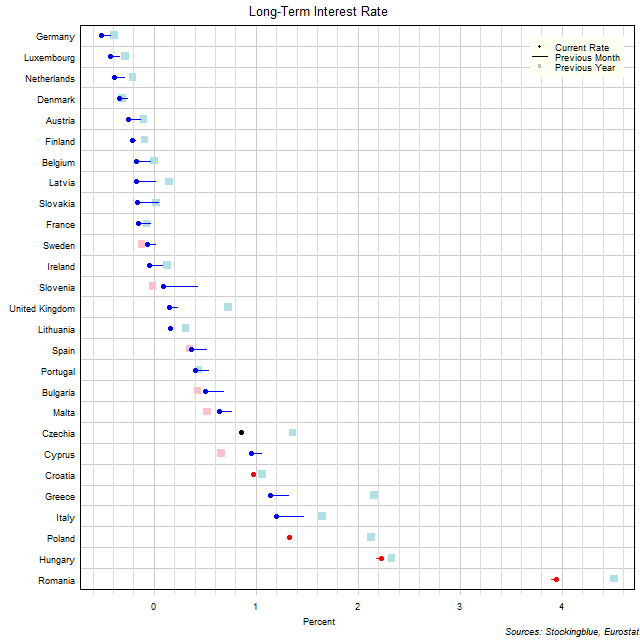
The chart above shows the ten-year interest rate in each EU state as of July 2020, the change from the previous month, and the rate one year prior. Twelve states have a negative interest rate (up from eight last month and up from nine last year).
Findings
- The difference (spread) between the state with the lowest long-term interest rate, Germany, and the state with the highest, Romania, is 4.46 percentage points (up from 4.32 last month and down from 4.90 last year). Germany had the lowest rate last year and last month. Romania had the highest rate last year and last month.
- The median long-term interest rate in the 28 EU states is 0.15 (down from 0.23 the previous month and down from 0.31 last year) and the mean 0.45 (down from 0.55 the previous month and down from 0.64 last year).
- One state saw no change in the long-term interest rate from the previous month, 22 saw the rate decrease, and four states saw the rate increase.
- Zero states saw no change in the long-term interest rate from last year, 21 saw the rate decrease, and six states saw the rate increase.
Caveats
- Data is from July 2020, June 2020, and July 2019.
- Estonia does not currently issue any sovereign debt that complies with the definition of long-term interest rates for convergence purposes and no suitable proxy indicator has been identified, therefore there is no data available for Estonia.
- All figures are rounded to the nearest hundredth.
Details
Slovenia saw its rate drop the most over the previous month dropping 0.33 percentage points. On the flip side, Romania saw its rate rise the most gaining 0.05 percentage points. Year over year, Greece saw its rate drop the most with a 1.02 percentage point drop while Cyprus saw its rate rise the most gaining 0.29 percentage points.
Latvia (from 9th lowest rate to 7th lowest rate), Slovakia (from 11th to 9th), and Slovenia (from 15th to 13th) each went up two spots over the course of the month. Conversely, France (from 7th to 10th) dropped the most being bested by three states.
Over the course of the year, Latvia (from 13th to 7th) and the United Kingdom (from 20th to 14th) rose the most besting six states each. On the flip side, Sweden (from 5th to 11th) was bested by six states.
For reference, the United States' ten-year note was 2.06% in July 2019, 0.72% in June 2020, and 0.62% in July 2020, meaning that Malta, Czechia, Cyprus, Croatia, Greece, Italy, Poland, Hungary, and Romania have higher rates than the US. Japan's ten-year rate was -0.14% in July 2019, 0.02% in June 2020, and 0.02% in July 2020 being bested by Germany, Luxembourg, the Netherlands, Denmark, Austria, Finland, Belgium, Latvia, Slovakia, France, Sweden, and Ireland.
Data
| State | July 2019 | June 2020 | July 2020 |
|---|---|---|---|
| Austria | -0.1 | -0.13 | -0.25 |
| Belgium | 0 | -0.04 | -0.17 |
| Bulgaria | 0.43 | 0.68 | 0.5 |
| Croatia | 1.06 | 0.96 | 0.97 |
| Cyprus | 0.66 | 1.05 | 0.95 |
| Czechia | 1.36 | 0.86 | 0.86 |
| Denmark | -0.31 | -0.26 | -0.34 |
| Finland | -0.09 | -0.18 | -0.21 |
| France | -0.07 | -0.04 | -0.15 |
| Germany | -0.39 | -0.43 | -0.52 |
| Greece | 2.16 | 1.32 | 1.14 |
| Hungary | 2.33 | 2.18 | 2.23 |
| Ireland | 0.13 | 0.08 | -0.05 |
| Italy | 1.65 | 1.46 | 1.2 |
| Latvia | 0.15 | 0.01 | -0.17 |
| Lithuania | 0.31 | 0.17 | 0.16 |
| Luxembourg | -0.28 | -0.34 | -0.43 |
| Malta | 0.52 | 0.76 | 0.64 |
| Netherlands | -0.21 | -0.29 | -0.39 |
| Poland | 2.13 | 1.31 | 1.33 |
| Portugal | 0.44 | 0.53 | 0.4 |
| Romania | 4.51 | 3.89 | 3.94 |
| Slovakia | 0.02 | 0.04 | -0.16 |
| Slovenia | -0.01 | 0.42 | 0.09 |
| Spain | 0.35 | 0.51 | 0.37 |
| Sweden | -0.12 | 0.01 | -0.07 |
| United Kingdom | 0.73 | 0.23 | 0.15 |
Sources
Eurostat. 2020. "EMU Convergence Criterion Series - Monthly Data." Accessed September 7, 2020. https://appsso.eurostat.ec.europa.eu/nui/show.do?query=BOOKMARK_DS-055774_QID_-FA464A1_UID_-3F171EB0&layout=TIME,C,X,0;GEO,L,Y,0;INT_RT,L,Z,0;INDICATORS,C,Z,1;&zSelection=DS-055774INDICATORS,OBS_FLAG;DS-055774INT_RT,MCBY;&rankName1=INDICATORS_1_2_-1_2&rankName2=INT-RT_1_2_-1_2&rankName3=TIME_1_0_0_0&rankName4=GEO_1_2_0_1&sortC=ASC_-1_FIRST&rStp=&cStp=&rDCh=&cDCh=&rDM=true&cDM=true&footnes=false&empty=false&wai=false&time_mode=NONE&time_most_recent=false&lang=EN&cfo=%23%23%23%2C%23%23%23.%23%23%23.
Eurostat. 2020. "Government Bond Yields, Ten Years' Maturity - Monthly Data." Accessed September 7, 2020. https://appsso.eurostat.ec.europa.eu/nui/show.do?query=BOOKMARK_DS-054880_QID_-42D3F4D0_UID_-3F171EB0&layout=TIME,C,X,0;GEO,L,Y,0;MATURITY,L,Z,0;INDICATORS,C,Z,1;&zSelection=DS-054880INDICATORS,OBS_FLAG;DS-054880MATURITY,Y10;&rankName1=MATURITY_1_2_-1_2&rankName2=INDICATORS_1_2_-1_2&rankName3=TIME_1_0_0_0&rankName4=GEO_1_2_0_1&sortC=ASC_-1_FIRST&rStp=&cStp=&rDCh=&cDCh=&rDM=true&cDM=true&footnes=false&empty=false&wai=false&time_mode=NONE&time_most_recent=false&lang=EN&cfo=%23%23%23%2C%23%23%23.%23%23%23.